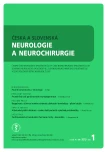Posttraumatic Transdural Spinal Cord Herniation – a Case Report
Authors:
Andrea Burgetová 1
; I. Kovářová 2; M. Vaněčková 1; Z. Seidl 1,3
Authors‘ workplace:
Radiodiagnostická klinika 1. LF UK a VFN v Praze
1; Neurologická klinika 1. LF UK a VFN v Praze
2; Vyšší zdravotnická škola, Praha
3
Published in:
Cesk Slov Neurol N 2013; 76/109(1): 96-98
Category:
Case Report
Overview
We describe a patient treated for a multiple sclerosis (MS)-like demyelinating disease. Magnetic resonance imaging (MRI) revealed a compressive fracture of the vertebral body T5 and transdural spinal cord herniation in this location. MRI was indicated due to worsening of clinical symptoms, suggestive of a spinal cord lesion. The patient had no history of spinal trauma, and we assume that the compressive fracture of vertebral body T5 resulted from osteoporosis due to long-term corticosteroid therapy. For these reasons, we do not know the exact timing of the spinal fracture and herniation. Post-traumatic spinal cord herniations are associated with variable time intervals of, usually, several years between the injury and clinical manifestation. There often is a gradual progression of clinical symptoms. A clinical picture of the presented patient is complicated by symptoms caused by MS. The aim of this manuscript is to demonstrate the options available for imaging of this relatively rare clinical unit on the background of clinical symptomatology. Neurosurgery can bring a significant improvement in patients with progression of clinical signs. Considerations on therapeutic management of our patient are further complicated by a possible overlap of clinical symptomatology with MS symptoms.
Key words:
spinal cord – herniation – fracture – magnetic resonance imaging – Brown-Séquard syndrome
Accepted for review:
17. 4. 2012
Accepted for print:
30. 7. 2012
Sources
1. Groen RJ, Coppes MH, Middel B. Spinal cord herniation: management and outcome. Acta Neurochir (Wien) 2012; 154(7): 1249–1250.
2. Watters MR, Stears JC, Osborn AG, Turner GE, Burton BS, Lillehei K et al. Transdural spinal cord herniation: imaging and clinical spectra. AJNR Am J Neuroradiol 1998; 19(7):1337–1344.
3. Urbach H, Kaden B, Pechstein U, Solymosi L. Herniation of the spinal cord 38 years after childhood trauma. Neuroradiology 1996; 38(2): 157–158.
4. Lee ST, Lui TN, Jeng CM. Spinal cord herniation after stabbing injury. Br J Neurosurg 1997; 11(1): 84–86.
5. Francis D, Batchelor P, Gates P. Posttraumatic spinal cord herniation. J Clin Neurosci 2006; 13(5): 582–586.
6. Spissu A, Peltz MT, Matta G, Cannas A. Traumatic transdural spinal cord herniation and the nuclear traio sign:case report. Neurol Sci 2004; 25(3): 151–153.
7. Kumar R, Taha J, Greiner AL. Herniation of the spinal cord. Case report. J Neurosurg 1995; 82(1): 131–136.
8. Tekkok IH. Spontaneous spinal cord herniation. Case report and review of the literature. Neurosurgery 2000; 46(2): 485–491.
9. Isu T, Iizuka T, Iwasaki Y, Nagashima M, Akino M, Abe H. Spinal cord herniation associated with intradural spinal arachnoid cyst diagnosed by magnetic resonance imaging. Neurosurgery 1991; 29(1): 137–139.
10. Uchino A, Kato A, Momozaki N, Yukitake M, Kudo S. Spinal cord herniation: report of two cases and review of the literature. Eur Radiol 1997; 7(2): 289–292.
11. Parmar H, Park P, Brahma B, Gandhi D. Imaging of idiopathic spinal cord herniation. Radiographics 2008; 28(2): 511–518.
12. Nakamura M, Fujiyoshi K, Tsuji O, Watanabe K, Tsuji T, Ishii K et al. Long-term surgical outcomes of idiopathic spinal cord herniation. J Orthop Sci 2011; 16(4): 347–351.
13. Groen RJ, Middel B, Meilof JF, JB de Vos-van de Biezenbos, Enting RH, Coppes MH et al. Operative treatment of anterior thoracic spinal cord herniation: three new cases and an individual patient data meta-analysis of 126 case reports. Neurosurgery 2009; 64 (Suppl 3): : 145–160.
Labels
Paediatric neurology Neurosurgery NeurologyArticle was published in
Czech and Slovak Neurology and Neurosurgery

2013 Issue 1
- Advances in the Treatment of Myasthenia Gravis on the Horizon
- Spasmolytic Effect of Metamizole
- Metamizole at a Glance and in Practice – Effective Non-Opioid Analgesic for All Ages
Most read in this issue
- Use of Botulinum Toxin in Neurology
- Frequent Incidence of Lyme Neuroborreliosis in Children in the Czech Republic
- Tetanus – a Reborn Diagnosis? A Case Report
- Hydrocephalus as a Complication of Subarachnoid Hemorrhage
